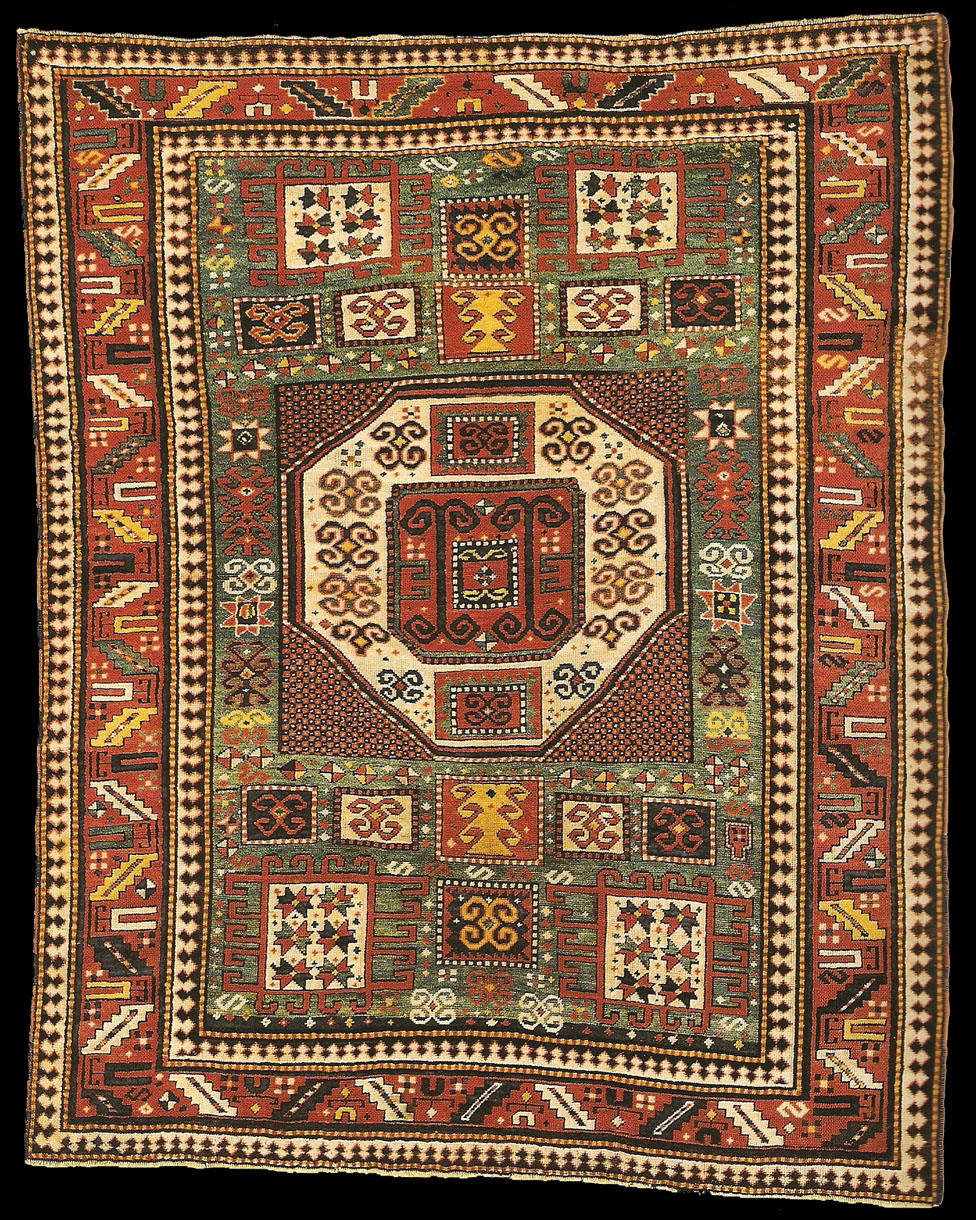|
Karachoph Kazak
Southwestern Caucasus
Second half of the 19th century
Wool pile on wool foundation
224 x 178 cm
The village of Karachoph, north of Lake Sewan, has given its name to
different Kazak patterns, the most ' typical of which is shown here. It is a
centralized composition dominated by a large octagonal medallion inscribed
in a rectangle or square and surrounded by four rectangles with hooked
contours, containing small, eight-pointed stars. This type of composition,
generally defined 1:4 has truly ancient origins and is found mainly in
Anatolian Turkish specimens of the early Ottoman era. It is called Holbein
for the German artist Hans Holbein the Younger who depicted one in a famous
painting. In Turkey this type of composition was
conserved through the centuries in the Pergamo district of Western Anatolia,
while in the Caucasus it was inherited, so to speak, from the Karachop and
other, such as Sumakh, rugs. To say "inherited" is not actually incorrect
because it is clear that in these case it was a common tribal heritage that
was transmitted to populations that descended from the same ethnic groups,
the Turks of Central Asia. The large central octagon with the ivory
background contains a smaller, red octagon between two rectangles of the
same color. The whole is decorated by a series of double-ram's horn (kotchak)
ornaments of definite Turkmen origin. Other rectangles with similar motifs
are scattered around the large octagon on the field, that is a typical
green/blue and richly decorated with other motifs that include the kotchak,
eight-pointed stars, small quadripartite diamonds, "S" shapes, totem tree
motifs, etc.
The wide border that surrounds this compositions comprises two medacyl
frames that enclose a main band in red with the "chalice and leaf" motif.
This type of border is quite common among Caucasian rugs, but it too is
based on Turkish models as borne out by the fact that it can be found not
only in nineteenth century Bergama rugs, but even in 16th and 17th rugs as
well as in the Lotto carpets.
 |
Karachoph Kazak
Caucaso Sud Occidentale
Seconda meta del XIX secolo
Vello in lana su armatura in lana
224 x 178 cm
Il villaggio di Karachoph, a nord del Lago Sewan, ha dato il nome a due
diversi disegni di Kazak, il piu tipico e caratteristico del quali e quello
rappresentato dall'esemplare qui a fianco illustrato. Si tratta di una
composizione centralizzata, dominata da un grande medaglione ottagonale
iscritto dentro un rettangolo o un quadrato e circondato da quattro
rettangoli dal profilo uncinato, contenenti piccole stefle a otto punte.
Questo tipo di composizione defmita solitamenle 1:4 ha un'origine molto
antica e si ritrova soprattutto negli esemplari turchi anatolici del primo
periodo ottomano conosciuti come Holbein, dal nome del pittore tedesco Hans
Holbein il giovane, che ne ha raffigurato uno in un celebre dipinto. In
Turchia questo tipo di composizione si e conservato attraverso i secoli nei
tappeti dell'area di Pergamo in Anatolia Occidentale, mentre nei Caucaso e
stato, per cosi dire, ereditato oltre che dai tappeti di Karachop, anche da
altre tipologie, come i Sumakh. Dire 'ereditato' non e sbagliato, perche e
chiaro che in questo caso si tratta di un retaggio tribaie comune, che si e
trasmesso in popolazioni che discendono dallo stesso gruppo etnico, quello
dei Turchi originari dell'Asia Centrale. Il grande ottagono centrale a fondo
avorio contiene un ottagono piu piccolo in rosso, compreso tra due
rettangoli dello stesso colore. II tutto e decorato da una serie di
ornamenti a doppie corna di montone (kotchak) di sicura origine turcomanna.
Altri rettangoli con motivi analoghi sono sparsi attorno al grande ottagono
sul campo, di un caratteristico colore verde/azzurro, riccamente decorato
anche da molti altri motivi sparsi, tra i quali ancora kotchak, stelle a
otto punte, piccole losanghe quadripartite, forme ad 'S', motivi totemici ad
albero, ecc. L'ampia bordura, che circonda questa composizione e formata da
due cornici di medacyl, che racchiudono una fascia principale in rosso con
il motivo solitamente definito: 'a foglie e calice'. Si tratta di un tipo di
bordura molto diffuso tra i tappeti del Caucaso, ma derivato anch'esso da
modelli turchi, come dimostra il fatto di ritrovarlo, non solo in esemplari
di Pergamo dell'Ottocento, ma addirittura in tappeti '5-'600, come in alcuni
cosiddetti 'Lotto'.
|

